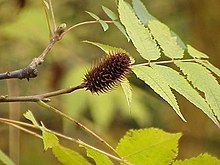bio.wikisort.org - Plant
Platycarya strobilacea is a species of flowering plant in the family Juglandaceae, formerly treated as comprising the single living species in Platycarya, though a second living species Platycarya longzhouensis is now recognized. It is native to eastern Asia in China, Korea, and Japan.[1][2]

| Platycarya strobilacea | |
|---|---|
 | |
| Autumn foliage and fruit | |
| Scientific classification | |
| Kingdom: | Plantae |
| Clade: | Tracheophytes |
| Clade: | Angiosperms |
| Clade: | Eudicots |
| Clade: | Rosids |
| Order: | Fagales |
| Family: | Juglandaceae |
| Genus: | Platycarya |
| Species: | P. strobilacea |
| Binomial name | |
| Platycarya strobilacea Siebold & Zucc. | |
It is a deciduous tree growing to 15 m tall. The leaves are usually pinnate, 15–30 cm long with 7–15 leaflets (rarely simple, or with up to 23 leaflets), the terminal leaflet present; the leaflets are 3–11 cm long and 1.5–3.5 cm broad. The flowers are catkins; the male (pollen) catkins are 2–15 cm long, the female catkins 2.5–5 cm long at maturity, hard and woody, superficially resembling a conifer cone with spirally arranged scales.[1][2] Galloyl pedunculagin can be found in P. strobilacea.[3]
References
- Flora of China: Platycarya
- Flora of China: Platycarya strobilacea
- Ueno, T.; Miyanaga, T.; Kawakami, F.; Okano, M.; Tanaka, T.; Ohtsuki, K. (2002). "Further characterization of galloyl pedunculagin as an effective autophosphorylation inhibitor of C-kinase in vitro". Biological & Pharmaceutical Bulletin. 25 (11): 1401–1404. doi:10.1248/bpb.25.1401. PMID 12419947.
 Media related to Platycarya strobilacea at Wikimedia Commons
Media related to Platycarya strobilacea at Wikimedia Commons
Другой контент может иметь иную лицензию. Перед использованием материалов сайта WikiSort.org внимательно изучите правила лицензирования конкретных элементов наполнения сайта.
WikiSort.org - проект по пересортировке и дополнению контента Википедии